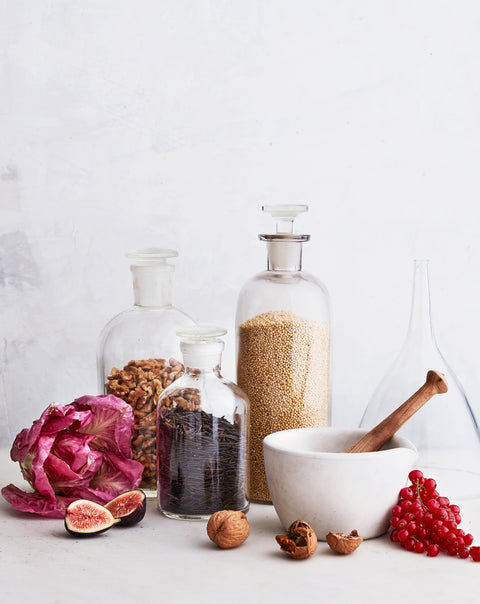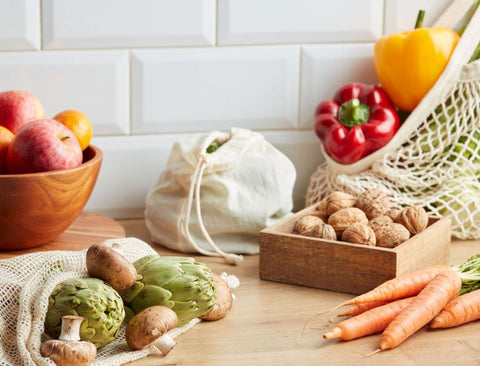Smart food choices can help us prevent or even reverse diabetes, and treat chronic pain, depression, and more.
Trailblazing new research shows that what we eat can do far more than simply provide energy and help keep us lean. When we choose our foods wisely and consistently, we can prevent or even reverse diabetes, and treat chronic pain, depression, and more. The right foods can also help stave off more serious health concerns—like cancer—down the road. To aid in prevention, the phytonutrients in almost all fruits and vegetables have beneficial properties, says Los Angeles oncology dietitian L. J. Amaral, RD. Aim to eat a wide range. Broccoli sprouts contain a particularly potent cancer-fighting compound, sulforaphane, which can help regulate cell growth and clear damaged cells from the body.
And while it’s true that you can spot some superfoods by their vibrant color, (we see you, purple radicchio), neutral-looking ingredients—like the walnuts, whole-grain millet, and forbidden rice shown here—can be nutritional gold, too. Ahead, what to pile on your plate to treat whatever ails you.
Support Your Stomach
Your gut and intestines are home to your microbiome, a collection of trillions of bacteria and other microorganisms that influence your health in big ways. Eating the right things feeds the so-called good bugs that live there, positively affecting not only digestion but metabolism, mood, immune function, inflammation, and gene expression, says Will Bulsiewicz, MD, a gastroenterologist in Charleston, South Carolina, and author of the new book Fiber Fueled ($27, barnesandnoble.com). A poor diet, on the other hand, can quash microbial diversity and negatively impact all of these systems. When you change how you eat, you reap the rewards quickly, too: A 2014 study published in Nature found that within a day (yes, a day) of shifting a diet for the better, gut composition starts to improve.
As for what to eat to support your gut? The rainbow, with all the fixings—vegetables, fruits, and herbs, plus whole grains, nuts, seeds, and beans. When gut bacteria feed on and ferment the fiber in plant foods, they produce compounds called short-chain fatty acids; one type is butyrate, which has anti-inflammatory effects and serves as a main source of nutrition for cells in the colon, benefitting overall digestion. In 2018, the American Gut Project found that people who ate more than 30 different types of plants per week had a healthier gut microbiome than those who ate fewer than 10. To pack 10 or more into one meal, blend a smoothie with mixed greens, assorted berries, nut butter, avocado, hemp seeds, and almond milk. Check off the remaining 20 by remixing your salads with guest stars like mint, cannellini beans, and sugar snap peas.
Soothe Chronic Pain
Inflammation is one potential side effect of an unhealthy microbiome. It’s also a driver of many different kinds of pain. We set it off system-wide when an imbalance of good and bad microbes damages our gut and allows a noxious substance called bacterial endotoxin to “leak” into the bloodstream; eat to support your microbiome, and you can prevent this from happening. Certain foods may also target pain more directly: Those rich in polyphenols, such as berries, show particular promise for alleviating arthritis, while vitamin C-rich picks may calm the immune system and reduce symptoms of autoimmune disorders, including lupus flare-ups, says William W. Li, MD, an internal-medicine physician in Boston and the author of Eat to Beat Disease ($17.99, target.com).
Citrus, bell peppers, and broccoli, along with blueberries, nuts, spices, black tea, and spinach (preferably doused in EVOO, which has oleocanthal—a polyphenol with anti-inflammatory properties similar to ibuprofen’s)—are all helpful for easing chronic pain. When consumed consistently, turmeric helps counter pain through the same pathways anti-inflammatory drugs use; add a teaspoon to smoothies or chicken salad, or consider a standardized turmeric-extract supplement. Tart cherry juice (refreshing with seltzer) has also been repeatedly proven to lower levels of C-reactive protein, a biomarker of inflammation associated with the aches.
Balance Blood Sugar
A staggering 88 million Americans (more than one in three) have prediabetes, and more than 30 million of us have type 2 diabetes. These diagnoses are often avoidable and reversible with good nutrition. The top priority for prevention and management is carbohydrate reduction as part of a healthy diet, says Ali Miller, RD, a dietitian and certified diabetes educator in Austin, Texas. In a 2014 study published in PLOS One, consuming 50 grams of net carbs or less a day helped overweight and obese patients who had prediabetes or type 2 diabetes reduce their hemoglobin A1C levels (a marker of average blood sugar over several months) by 0.6 percent. This marker didn’t budge for people eating a more typical diet recommended by doctors for diabetes management, with 165 grams of carbs daily. Low-carb dieters also lost twice as much weight, and many were able to scale back on diabetes meds.
Replace most refined carbs (breads, crackers, cereal—yes, even whole-grain varieties) and sugars with whole-food carbs from fiber-rich vegetables, low-glycemic fruits (like grapefruit and peaches), and legumes. Pick your favorites from that list, and pair them with protein and fat to blunt blood-sugar spikes. Miller suggests drawing a line at 60 to 75 grams of carbs a day, or at most 30 grams per meal. That’s not as spartan as it may sound: Wild salmon, asparagus, and a half-cup of roasted sweet potatoes cooked in olive oil fit the bill nicely, as does a cup of Greek yogurt with chia seeds and a half-cup of berries. Also start sipping ginger tea, or add cinnamon to your coffee or oats—both spices contain compounds that can lower post-meal blood-sugar levels. Magnesium-rich foods also aid in carb metabolism and glucose regulation; get more from dark leafy greens (kale, spinach, collards), a handful of almonds, or a one-ounce square of 80 percent (or greater) dark chocolate.
Lift Your Mood
Yes, you can eat yourself happy—just not with ice cream. That’s what an emerging field called nutritional psychiatry is finding. A 2019 study from Australia’s Macquarie University observed that sticking to a Mediterranean diet reduced depression symptoms to the “normal” range for participants within three weeks. Other research suggests that B vitamins, omega-3 fatty acids, magnesium, and zinc can quell depression and anxiety, in part by influencing mood-regulating chemical messengers in the brain like serotonin, says nutritional psychiatrist Uma Naidoo, MD, director of nutritional and lifestyle psychiatry at Massachusetts General Hospital, in Boston, and author of the forthcoming book This Is Your Brain on Food (available for pre-order, book.umanaidoomd.com). Gut health plays a role too, per Dr. Bulsiewicz; recent studies link the consumption of probiotic-rich fermented foods like yogurt and certain probiotic strains (e.g., L. rhamnosus) to reduced anxiety.
To boost that serotonin, eat the things you’d enjoy in the Mediterranean. The participants in the Australian study were advised to make their plates colorful and diverse. Every day, they aimed for five servings of vegetables; two to three of fruit; and three each of whole grains, proteins (such as lean meat, eggs, poultry, and tofu), and plain dairy, plus three tablespoons of nuts and seeds, and two tablespoons of olive oil. They frequently added a teaspoon of cinnamon or turmeric to their meals, and sat down to three servings of fish a week. Salmon and shellfish are ideal, since they pack zinc, B vitamins, and omega-3s.
Martha Stewart Living, June 2020
- By Stephanie Eckelkamp




